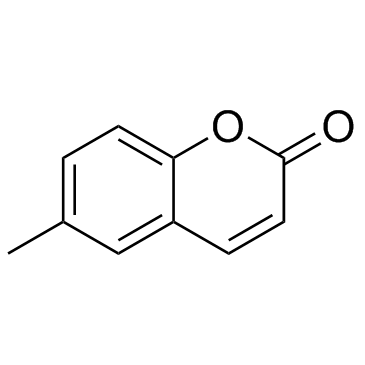6-甲基香豆素

6-甲基香豆素结构式

|
常用名 | 6-甲基香豆素 | 英文名 | 6-Methylcoumarin |
|---|---|---|---|---|
| CAS号 | 92-48-8 | 分子量 | 160.169 | |
| 密度 | 1.2±0.1 g/cm3 | 沸点 | 304.6±21.0 °C at 760 mmHg | |
| 分子式 | C10H8O2 | 熔点 | 73-76 °C(lit.) | |
| MSDS | 中文版 美版 | 闪点 | 124.3±19.5 °C | |
| 符号 |


GHS07, GHS08 |
信号词 | Danger |
|
Non-animal photosafety screening for complex cosmetic ingredients with photochemical and photobiochemical assessment tools.
Regul Toxicol Pharmacol 72 , 578-85, (2015) Previously, a non-animal screening approach was proposed for evaluating photosafety of cosmetic ingredients by means of in vitro photochemical and photobiochemical assays; however, complex cosmetic ingredients, such as plant extracts and polymers, could not b... |
|
|
A kinetic study of the main guaco metabolites using syrup formulation and the identification of an alternative route of coumarin metabolism in humans.
PLoS ONE 10(3) , e0118922, (2015) For decades guaco species have been empirically used for the treatment of respiratory diseases. However, studies have shown that the toxic and therapeutic effects of the main guaco metabolites are dose-dependent, and none clinical study was done to evaluate t... |
|
|
Stable isotope labeling method for the investigation of protein haptenation by electrophilic skin sensitizers.
Toxicol. Sci. 142(1) , 239-49, (2014) The risk of contact sensitization is a major consideration in the development of new formulations for personal care products. However, developing a mechanistic approach for non-animal risk assessment requires further understanding of haptenation of skin prote... |
|
|
Perfume dermatitis.
J. Am. Acad. Dermatol. 12(1 Pt 1) , 1-9, (1985) The most common reaction to fragrance materials seen by practicing dermatologists is allergic contact dermatitis. Photodermatitis is occasionally seen, as is contact urticaria, irritation, and depigmentation. Fragrances are the leading cause of allergic conta... |
|
|
Phosphorylation of histone H2AX is a powerful tool for detecting chemical photogenotoxicity.
J. Invest. Dermatol. 131(6) , 1313-21, (2011) Several light-absorbing chemicals are known to show phototoxic effects involving many kinds of DNA damage, and are suspected of initiating skin cancer. In this study, we clarified that phosphorylated histone H2AX (γ-H2AX) (phosphorylated histone H2AX), which ... |
|
|
Induction of keratinocyte apoptosis by photosensitizing chemicals plus UVA.
J. Dermatol. Sci. 45(2) , 105-12, (2007) The capacity of photosensitizing chemicals with ultraviolet A light (UVA) to induce apoptosis is one of the methods to assess their phototoxic and potentially photoallergic properties, since apoptotic cells may be easily presented by antigen-presenting cells.... |
|
|
Simultaneous determination of 6-methylcoumarin and 7-methoxycoumarin in cosmetics using three-dimensional excitation-emission matrix fluorescence coupled with second-order calibration methods.
Talanta 75 , 1260-1269, (2008) This paper reports a simple, rapid, and effective method for quantitative analysis of 6-methylcoumarin (6-MC) and 7-methoxycoumarin (7-MOC) in cosmetics using excitation-emission matrix (EEM) fluorescence coupled with second-order calibration. After simple pr... |
|
|
Mechanism for 6-methylcoumarin photoallergenicity.
Toxicol. Appl. Pharmacol. 81(2) , 295-301, (1985) 6-Methylcoumarin (6-MC), a synthetic fragrance material, has been reported to be photoallergenic both in man and in guinea pigs. To elucidate the possible mechanism of photoallergenicity, 6-MC in ethanolic solution was exposed to 200 joules/cm2 of long-wavele... |
|
|
Fourier transform-infrared and Raman spectra, ab initio calculations and assignments for 6-methyl-4-bromomethylcoumarin.
Spectrochim. Acta. A. Mol. Biomol. Spectrosc. 64(2) , 301-7, (2006) Fourier transform-infrared (4000-400 cm-1) and Raman (3500-50 cm-1) spectral measurements have been made for 6-methyl-4-bromomethylcoumarin. Equilibrium structures, harmonic vibrational frequencies, infrared intensities, and depolarization ratios have been co... |
|
|
Development of a highly sensitive in vitro phototoxicity assay using the SkinEthic reconstructed human epidermis.
Cell Biol. Toxicol. 16(6) , 391-400, (2000) The reconstituted human epidermis model SkinEthic was used to evaluate the phototoxicity of topically applied chemicals. For comparison with published data, we first tested a library of 13 nonphototoxic (NPT) and phototoxic (PT) compounds, applied onto SkinEt... |